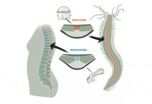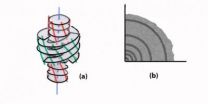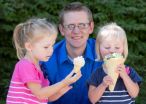(Press-News.org) AUDIO:
Professor Peter Piot, Director of the London School of Hygiene & Tropical Medicine, explains how he co-discovered the Ebola virus in 1976, and gives his views on the current Ebola...
Click here for more information.
The current Ebola outbreak now requires a "rapid response at a massive global scale", according to experts at the London School of Hygiene & Tropical Medicine.
Writing an editorial in Science, Professor Peter Piot, co-discoverer of the virus, says that the epidemic in West Africa is the result of a "perfect storm" involving dysfunctional health services, low trust in governments and Western medicine, denials about the virus's existence, and unhygienic burial practices.
The outbreak which began in December 2013 now spans five countries in West Africa and has so far killed nearly 2000 people, with the WHO predicting that 20,000 may become infected.
Professor Piot, Director of the London School of Hygiene & Tropical Medicine, writes: "This fast pace of Ebola's spread is a grim reminder that epidemics are a global threat and that the only way to get this virus under control is through a rapid response at a massive global scale—much stronger than the current efforts."
According to Professor Piot, international assistance to the growing local efforts must include support for disease-control activities such as the provision of protective equipment, patient care, and addressing the health, nutritional, and other needs of populations in quarantine.
It is also an opportune time to accelerate evaluation of experimental therapies and vaccines. With the WHO announcing that compassionate use of experimental therapies is ethically justified, even if they have not been tested in humans, Professor Piot comments that "an exceptional crisis requires an exceptional response."
In a separate article in Eurosurveillance, Professor Piot and colleague Dr Adam Kucharski, Research Fellow in Infectious Disease Epidemiology at the London School of Hygiene & Tropical Medicine, delve deeper into the challenges currently facing West Africa. They warn that the exponential growth in numbers makes tracing and surveillance for Ebola increasingly difficult, and that cases could double every fortnight if the situation remains the same.
Professor Piot and Dr Kucharski write: "Fear and mistrust of health authorities has contributed to this problem, but increasingly it is also because isolation centres have reached capacity. As well as creating potential for further transmission, large numbers of untreated – and therefore unreported – cases make it difficult to measure the true spread of infection, and hence to plan and allocate resources."
They also warn that it is not just Ebola patients who are affected by the outbreak. In cities like Monrovia in Liberia, the infection has led to the closure of most health facilities, and as a result, untreated injuries and illnesses have caused further loss of life.
INFORMATION:Notes to Editors:
Peter Piot. Ebola's Perfect Storm. Science. DOI: 10.1126/science.1260695
Adam J Kucharski, P Piot. Containing Ebola virus infection in West Africa. Eurosurveillance. 2014;19(36):pii=20899
For more information, please contact the London School of Hygiene & Tropical Medicine press office on +44(0)2079272802 or press@lshtm.ac.uk.
Experts call for massive global response to tackle Ebola
2014-09-12
ELSE PRESS RELEASES FROM THIS DATE:
Stanford-led study assesses the environmental costs and benefits of fracking
2014-09-12
A strange thing happened on the way to dealing with climate change: Advances in hydraulic fracturing put trillions of dollars' worth of previously unreachable oil and natural gas within humanity's grasp.
The environmental costs – and benefits – from "fracking," which requires blasting huge amounts of water, sand and chemicals deep into underground rock formations, are the subject of new research that synthesizes 165 academic studies and government databases. The survey covers not only greenhouse gas impacts but also fracking's influence on local air pollution, earthquakes ...
Piglet health
2014-09-12
Porcine neonatal coccidiosis is a serious parasitic infection of young piglets that severely damages the intestinal mucosa, leading to diarrhoea and reduced nutritional intake. As the infection reduces animal growth, and because secondary infections can result in increased mortality, the disease is responsible for substantial economic losses at affected pig farms.
"The developing immune system of neonatal piglets is not yet mature enough to deal with the parasites. For this reason, an infection shortly after birth results in weakened intestinal tissue with appropriate ...
Moving silicon atoms in graphene with atomic precision
2014-09-12
Richard Feynman famously posed the question in 1959: is it possible to see and manipulate individual atoms in materials? For a time his vision seemed more science fiction than science, but starting with groundbreaking experiments in the late 1980s and more recent developments in electron microscopy instrumentation it has become scientific reality. However, damage caused by the electron beam is often an issue in such experiments.
The present study focused on single-layer graphene with silicon atoms embedded into the lattice, previously created and studied by the collaborators ...
Cutting the cloud computing carbon cost
2014-09-12
Cloud computing involves displacing data storage and processing from the user's computer on to remote servers. It can provide users with more storage space and computing power that they can then access from anywhere in the world rather than having to connect to a single desktop or other computer with its finite resources. However, some observers have raised concerns about the increased energy demands of sustaining distributed servers and having them up and running continuously, where an individual user's laptop might be shut down when it is not in use or the resources utilization ...
From worm muscle to spinal discs
2014-09-12
Thoughts of the family tree may not be uppermost in the mind of a person suffering from a slipped disc, but those spinal discs provide a window into our evolutionary past. They are remnants of the first vertebrate skeleton, whose origins now appear to be older than had been assumed. Scientists at the European Molecular Biology Laboratory (EMBL) in Heidelberg, Germany, have found that, unexpectedly, this skeleton most likely evolved from a muscle. The study, carried out in collaboration with researchers at the Howard Hughes Medical Institute in Janelia Farm, USA, is published ...
New family of materials for energy-efficient information storage and processing
2014-09-12
Switching the polarity of a magnet using an electric field (magnetoelectric memory [MEM] effect), can be a working principle of the next-generation technology for information processing and storage. Multiferroic materials are promising candidates for the MEM effect, due to the coexistence of electric and magnetic orders. On the other hand, the coexistence of spontaneous electric and magnetic polarizations is rare in known materials, which hinders the application potential of the MEM effect. This article briefly reviews a new family of multiferroic materials—hexagonal rare ...
Conjecture on the lateral growth of Type I collagen fibrils
2014-09-12
Whatever the origin and condition of extraction of type I collagen fibrils, in vitro as well as in vivo, the radii of their circular circular cross sections stay distributed in a range going from 50 to 100 nm for the most part of them. Jean Charvolin and Jean-Francois Sadoc from the solid state physique laboratory at the Paris-Sud University propose therefore that, once the growth of the fibrils has been triggered by external biological factors, their lateral size be limited by internal physical stresses generated during the growth. Their conjecture is based ...
Extension of standard model by knot algebra
2014-09-12
This paper makes a connection between the quantum group SLq(2), which described knots, and the elementary particles of the standard model. The elements of the fundamental (j = 1/2) representation of SLq(2) are interpreted as creation operators for preons. The preons interact through a preonic vector field defined by elements of the adjoint (j = 1) representation. The leptons and quarks then appear (as required by the electroweak data) as elements of the j = 3/2 representation. Unexpectedly the electroweak quantum numbers of the so defined preons, leptons, and quarks agree ...
Scientists show that nicotine withdrawal reduces response to rewards across species
2014-09-12
Cigarette smoking is a leading cause of preventable death worldwide and is associated with approximately 440,000 deaths in the United States each year, according to the U.S. Centers for Disease Control and Prevention, but nearly 20 percent of the U.S. population continues to smoke cigarettes. While more than half of U.S. smokers try to quit every year, less than 10 percent are able to remain smoke-free, and relapse commonly occurs within 48 hours of smoking cessation. Learning about withdrawal and difficulty of quitting can lead to more effective treatments to help smokers ...
Favoritism linked to drug use in 'disengaged' families
2014-09-12
Before you revive the debate about which sibling in your family is the favorite, you'll want to know what the latest research shows.
Brigham Young University professor Alex Jensen analyzed 282 families with teenage siblings for a study that appears in the Journal of Family Psychology. Favoritism in parenting is a complex topic for sure, but here are some important take-aways.
Does it really matter?
Yes, at least for some families. Jensen looked at perceived preferential treatment in different types of family dynamics. For families that aren't very close to each other ...





